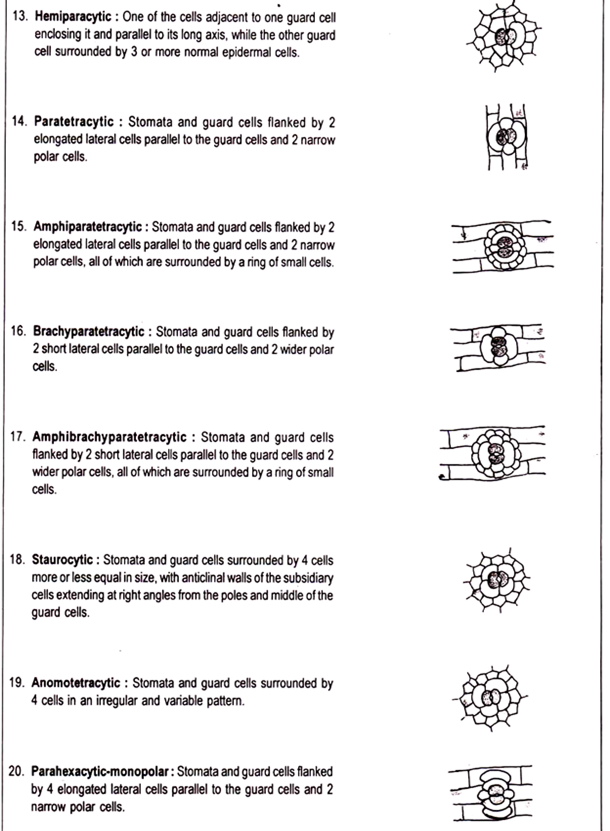In this article we will discuss about the Quiescent Centre (QC) found in root-promeristem of higher plants.
It is observed that in the root-promeristem of higher plants the initials divide much less frequently than other cells. This part of root-promeristem, which contains the initials of epidermis, cortex and stele and divides less frequently, is referred to as quiescent centre (QC). Quiescent centre is situated at the pole of cortex and stele and consists of four cells (e.g. Arabidopsis) or as high as 600 cells that have very low mitotic activity (Fig. 7.24).
In closed meristem QC appears more or less hemispherical whereas in open meristem it is disc-shaped. The cells composing QC exhibit smallest dictyosomes, nuclei and nucleoli. The cells also exhibit little endoplasmic reticulum and fewer mitochondria. The cells contain lower concentration of RNA, DNA and protein than other cells of root apex.
Quiescent centre is unusual in shoots, but it is universal in roots of higher plants. Though the occurrence of QC was reported in vascular cryptogams (e.g. Equisetum arvense) later investigations have established that the entire root apex of vascular cryptogams is mitotically active. Quiescent centre maintains a strict boundary in closed meristem. As a result the derivatives of QC also maintain a strict boundary in the apical zone.
Quiescent centre consists of central cells only or central cell and part of its peripheral zones. It does not include the mother cells of columella. A separate cap meristem exists and it forms root cap. In open meristem the size and position of QC change.
They fluctuate as the root ages and grow bigger. The volume and number of constituent cells of QC vary with the change of width of root. In growing roots QC is small. The columella mother cells are generated from the cells situated ahead of the central cell.
It needs special techniques to identify QC. It can be identified in autoradiograph of root sections. Supplying root with solutions of thymidine labeled with radioactive isotope hydrogen, tritium (3H), the nuclei of root apical meristem can be labeled. Radioactive thymidine incorporates specifically into DNA of DNA synthesizing cells.
All the nuclei except those of QC become radioactive because QC has low rate of DNA synthesis and so lack the incorporation of radioactive thymidine. To prepare autoradiograph roots were treated with radioactive thymidine and then fixed with fixative. The fixed roots were microtomed and the sections were placed in contact with auto-radiographic stripping film. All were kept in dark for several days.
The film was later developed and fixed. The film is sensitive to radiations emitted by radioactive substances and produces images of the locations from where the radiations were emitted. As the film is in direct contact with the sections of root the precise sites of radioactivity can be identified in autoradiograph. Mitotic figures and mitotic indices are also used to identify the QC.
Quiescent centre has the capability to generate the entire root including root cap. This is established in QC culture. Quiescent centre can be isolated and when the isolated QC is grown in suitable medium, it forms root from its proximal face and root cap from distal face. Normally root cap initials are generated outside the QC. But the isolated QC generates root cap initials.
In an experiment the root cap of maize is carefully removed so that the root proper is not otherwise damaged. It is observed that the cell division in QC is stimulated and the root grows faster. The cell divisions slow down as the new root cap is regenerated. Later studies reveal that direct contact of root cap and differentiated cells with QC inhibit the differentiation of initial cells.
Quiescent centre is regarded as central mother cells that form promeristem of root apex.
The followings are suggested regarding the function of QC:
i. It provides a reserve block of diploid cells when the root tip is damaged at the time of pushing through the soil.
ii. It is the site of hormone synthesis.
iii. As it is the source of some growth substances, at certain concentration of hormone it inhibits cell division and growth.
iv. Quiescence is caused due to the presence of root cap and the pressure exerted by the dividing initial cells. Cells of QC maintain a long period in the presynthesis (G1) phase of mitotic cycle and thus they may escape injury.
Earlier literatures emphasized regarding the presence and functioning of initiating layers in the root tips of seed plants. Researches during 1950s demonstrate the occurrence of QC in mature roots. Later studies reveal that in Arabidopsis thaliana QC and columella of root cap originate during embryogenesis.
In this species genetic studies of root meristem development demonstrate the presence of hbt (hobbit) gene, which is responsible for the development of the normal initiating layers in roots, i.e. dermatogen, periblem and plerome. Arabidopsis with mutant hbt (hobbit) gene lacks QC. Moreover in hbt mutant calyptrogen develops abnormally that generates root cap where columella is lacking.
Researches in molecular biology at the end of twentieth century definitely establish the fact that QC has a significant role in the development of root. Modern literatures describe QC ‘as an architectural template in the root apical meristem of all angiosperm and gymnosperm root tips ….’ — Beck.
Knowledge of meristem is an essential prerequisite in meristem culture. Meristems are cultured for vegetative propagation and micro-propagation that are practiced in forestry, horticulture, floriculture and conservation of endangered species etc. Shoot apical meristem culture is also used successfully to remove viruses, bacteria and fungi from plants.
This becomes possible due to:
(i) The occurrence of viruses in the meristem is much less than other cells.
(ii) The cells of meristem divide very fast.
(iii) The viruses cannot move quickly through plasmodesmata and thus unable to spread within the actively growing meristem tip.
